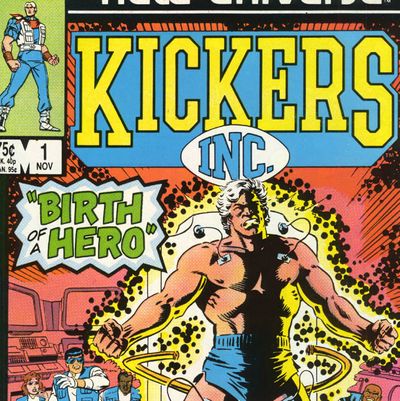
Two of the strangest pages to ever appear in a superhero comic were published by Marvel in 1986. They form the conclusion of the first issue of Kickers, Inc., a bizarre series about a group of football players who moonlight as costumed crimefighters. In the final scene, quarterback Jack “Mr. Magnificent” Magniconte talks with his football squad mates — the exotically nicknamed Suicide, Brick Wall, and Dasher — about how they should form a superteam because of … the tax advantages. Unlike, say, the Avengers, he explains, they would incorporate as a nonprofit foundation: “Yeah, we could write off all our travel and entertainment!” Dasher cries. “How ‘bout if I bought a new cycle or sports car for the foundation?” Suicide asks. Brick Wall responds, “All tax deductible.”
It should be noted that Kickers, Inc. was not a comedy or a satire.
Thirty years later, when Jim Shooter — who was editor-in-chief of Marvel at the time of Kickers, Inc.’s publication — is asked for his opinion of the series, his verdict is immediate: “Trainwreck.” In more than a few ways, he’s right. The book cycled through eight writers and six pencillers over the course of its 12-issue run, a volatile foundation that yielded whiplash-inducing shifts of tone and a mishmash of unrelated adventures, from a mystery about a robot destroying an elderly woman’s rose garden to a clash with a dual-gender circus performer. One character abruptly shifts from being nonwhite to white after the sixth issue due to a coloring error that nobody bothered to fix. Beyond all that, it’s unclear how, exactly, the Kickers do any of their evil-battling while still competing in the NFL.
And yet, there’s a unique magic to Kickers, Inc., the sort that can never exist in an artistic endeavor that’s handled … well. Reading the series, which doesn’t exist in trade paperback or on digital services like comiXology.com or Marvel Unlimited (try eBay), feels like listening to the radio while driving through a mountainous area where stations overlap with one another in thrilling cacophony. Or maybe it’s more like one of those party games where a person says a sentence of a story, then passes it off to another for the next sentence, and so on until you have a Frankenstein’s monster that no individual could have invented. Compared to our current era, when superhero fiction, thanks to its explosion at the box office, has become a market-tested and artistically conservative industry, Kickers was delightful in its unintentional insanity. But make no mistake, it was also insane.
That was perhaps inevitable, given the fact that Kickers emerged from a company in turmoil. It should have been a time of celebration: 1986 was the 25th anniversary of Marvel’s historic relaunch, which had been marked by the publication of 1961’s Fantastic Four No. 1. But all was not well in the so-called House of Ideas, as its parent company was being sold against Shooter’s wishes. As anyone who worked for Marvel at the time can tell you, Shooter was not a man who liked having his wishes gone against.
Not only was he displeased about what his superiors were doing, he was also chafing with his employees so regularly that the office climate had become white-hot. Writers, artists, and editors saw his approach as overly micromanaging and his personality as belligerent; he saw them as unwilling to accept change and guidance. “There was, maybe, a lot of stress on him, and …” says writer Terry Kavanagh, who went on to be one of the Kickers writers, before trailing off. “I’m trying to be diplomatic here. He got louder and angrier, and it was harder to hear his message. It was speeding up, the dissolution of the relationship between him and the editorial staff.”
Kickers sprung from one such conflict, relating to an idea Shooter had for how to commemorate 1986. “I said, ‘It’s the anniversary of the birth of a new universe, so let’s start another one,’” Shooter recalls. He wanted a new lineup of superhero series, all separate from the established Marvel Universe of the Avengers, X-Men, Spider-Man, and the like. The tales would take place in a new fictional universe called, bluntly enough, the New Universe, populated with previously unseen superheroes who would be theoretically free of the staleness and baggage of decades of history.
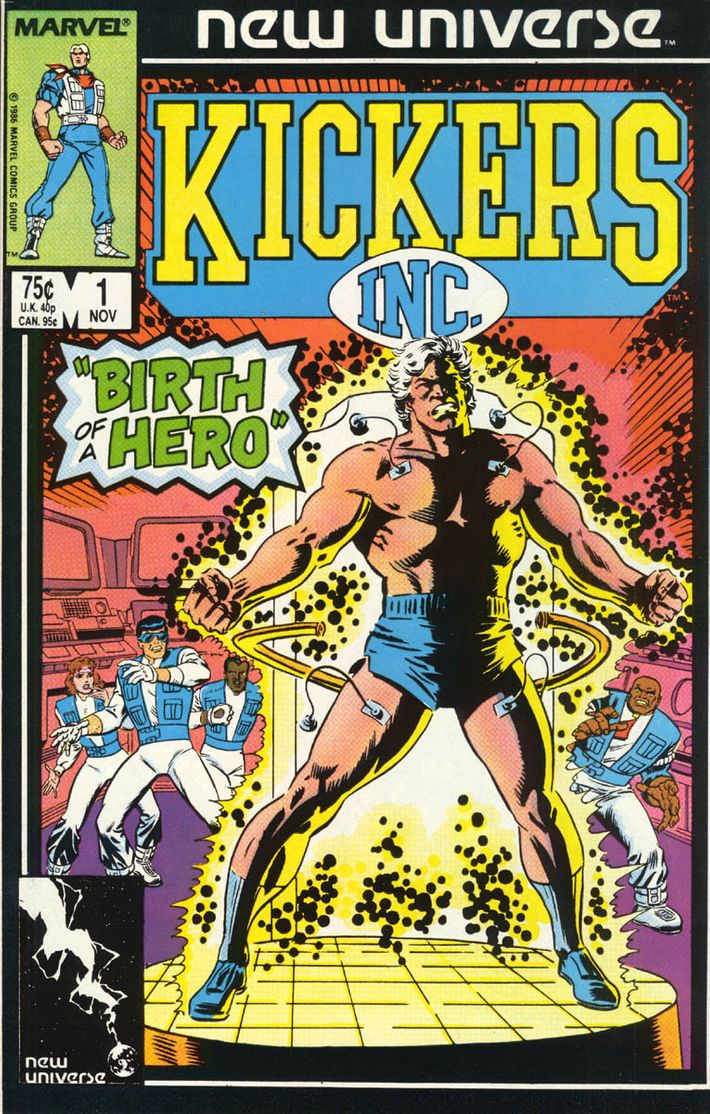
One of the biggest problems was that Shooter more or less created the New Universe initiative by fiat, and his subordinates were dragged along, grumbling and confused. Two such staffers were the creative team working on Amazing Spider-Man: writer Tom DeFalco and artist Ron Frenz, who would go on to launch Kickers. “I’m trying to figure out a diplomatic way of saying this,” DeFalco says when asked to describe his response to the New Universe initiative. “At the time, a number of us questioned the idea. ‘If we’re going to celebrate the anniversary of the Marvel Universe, why aren’t we celebrating the Marvel Universe? Can’t we create a whole new universe some other year?’ But Shooter was the boss, so …”
“Nobody knew initially, except Jim Shooter, what the New Universe exactly was,” recalls Frenz. “But Tom already had an idea kicking around with the working title of Mr. Magnificent and His Team Supreme.” It would be about a group of off-season football players who were going to travel the world in a “Supermobile” and, as Frenz puts it, “face living islands and monsters and mad scientists.” DeFalco says it would have been “an insane comic book where we could do any kind of ridiculous story that we felt like,” a slightly tongue-in-cheek but mostly loving homage to the wild sci-fi comics of the late ‘50s and early ‘60s. Both DeFalco and Frenz were casual football fans (the former, a Queens boy, loosely followed the Jets; the latter was from Pittsburgh, where disliking the Steelers is a felony), and though they weren’t sports nuts, Frenz thought the football angle “gave you a ready-made team mentality.” Under pressure to offer up New Universe pitches, DeFalco brought his odd little notion to Shooter. The EIC liked it. They’d call it Kickers, Inc.
But almost immediately afterward, DeFalco tried to stop what he’d begun. There was a crucial aspect of the New Universe that DeFalco says he wasn’t aware of when he went to his boss: Shooter wanted the endeavor to be rooted in something resembling realism. “The conceit I came up with was, Let’s do a more down-to-earth thing,” Shooter says. “That meant no Watcher on the moon or Atlantis under the water.” The motto he issued to his creators was, The world outside your window. Shooter thought a sports-oriented series would fit right in. But DeFalco, upon hearing about the New Universe’s tonal goal, realized right away that his concept would be a disastrously bad fit, what with the whole “insane comic book” thing he wanted to do. “Tom said, ‘You don’t want Kickers,’” Frenz recalls. “Jim said, ‘Yes, I do. I want a sports book.’ Tom said, ‘This isn’t a sports book. I don’t know that much about sports, Ron doesn’t know that much about sports. They’re off-season football players; that’s about as sporty as it gets.’ Jim goes, ‘I want a sports book. It’s going to be great, don’t worry about it.’ What we were faced with was taking the original concept, which was like a big-budget movie, and compacting it into a TV-movie treatment.” DeFalco and Frenz were in the bizarre position of being trapped by their own idea.
Nevertheless, they got to work on this awkward chimera of fantasy and football. DeFalco, still struggling to understand what the hell Shooter was going for, was forced to do revision after revision of the first issue’s script. Frenz drew it, but parts of it were redrawn by someone else to incorporate Shooter’s ideas about how various panels would look. Changes were being made so late in the game that the typographical style often differs from panel to panel, a result of a new letterer being brought in at the last minute. Here’s an example from page 18 — note how the lettering is thick on the left and thin on the right:
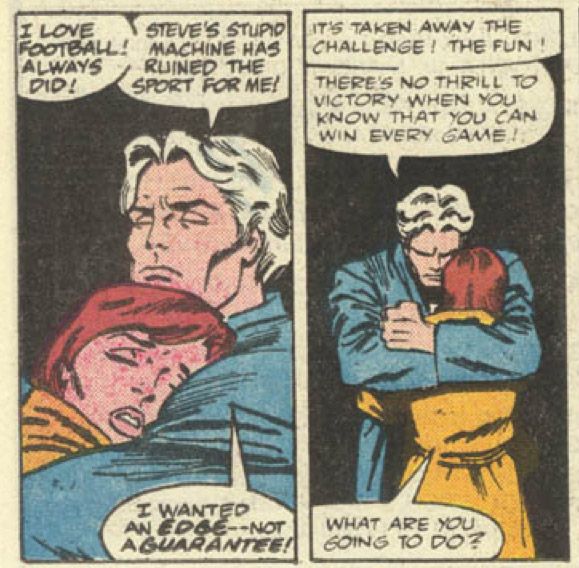
The finished product is, unsurprisingly, quite disjointed. We meet New York Smashers quarterback Jack Magniconte and his teammates Brick Wall, Suicide, and Dasher. They engage in locker-room antics after a big win and Brick Wall, for no particular reason (other than to add a Chekhov’s Gun to the narrative), monologues about financial security: “The right tax shelter does wonders for one’s sense of well-being!” he tells Jack. (“It was the ‘80s,” Frenz says with a laugh. “A lot of people were thinking about tax shelters back then!”) The lightheartedness abruptly disappears when Jack and his wife, Darlene, go to visit Jack’s brother Steve, a sports-medicine researcher with a gambling habit. Steve offers Jack a chance to try out an advanced machine that will “artificially stimulate an increase in muscle mass! Sort of like using steroids, only without the harmful effects.” Jack says yes.
On the day of the procedure, a global phenomenon called the White Event occurs, bathing humanity in a strange light that grants some people superpowers. Oddly enough, Jack doesn’t get his powers from that; he only becomes super-strong, super-fast, and nigh-invulnerable after he uses Steve’s machine. The White Event was a key element of the New Universe, but Frenz and DeFalco say they weren’t really told what it was, so its existence doesn’t make sense within the context of the plot — why would Jack need the machine to get the special abilities, if the big weird cosmic thing has already happened?
No matter; he gets the powers and quickly becomes bored with football because of how good he is at it. He tries to get Steve to change him back, only to walk in on his brother getting murdered by loan sharks; in the aftermath, he tells his teammates that he wants to use his powers for more than just football in order to give Steve’s death “meaning.” “You talking charity work? Soup kitchens?” Suicide asks. “Not quite, Suicide!” Jack replies. “We are who we are! Anything we get involved in has to be fun, and exciting!” What followed were the pages described earlier, which outline superhero tax loopholes before depicting the team deciding on its name: Jack’s wife Darlene calls them a bunch of “kickers,” and the men fancy the word. “Just needs a little modification to …” Brick Wall says in the penultimate panel, before the final one shows them pumping their fists in the air and yelling, “Kickers, Inc!!”
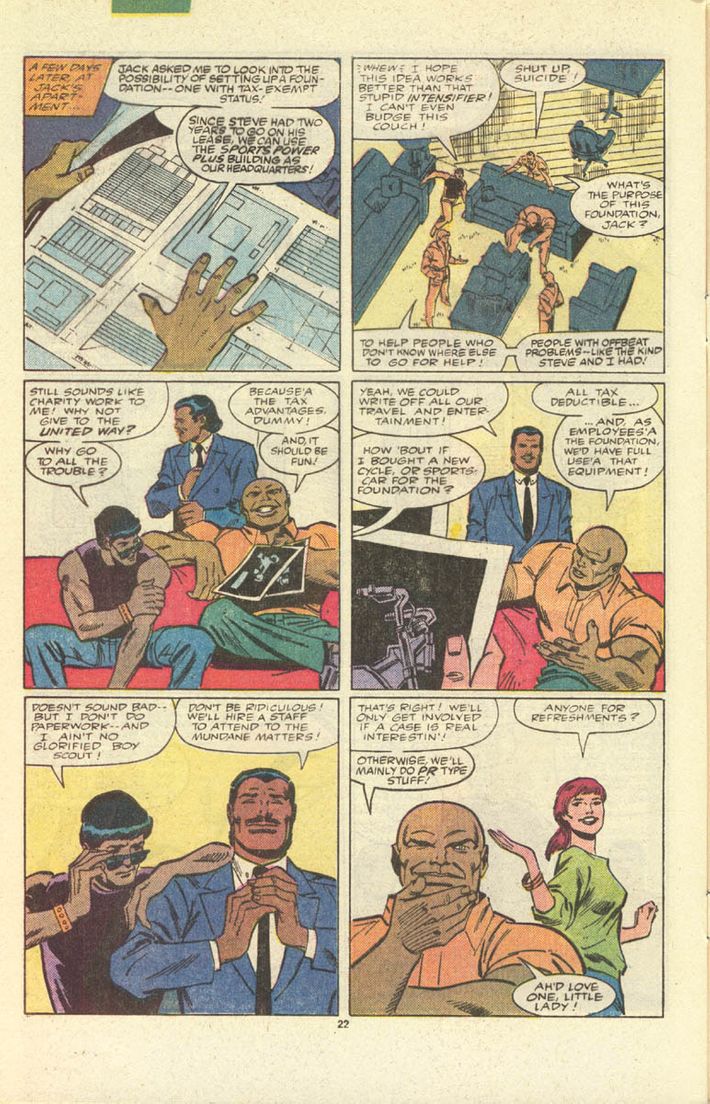
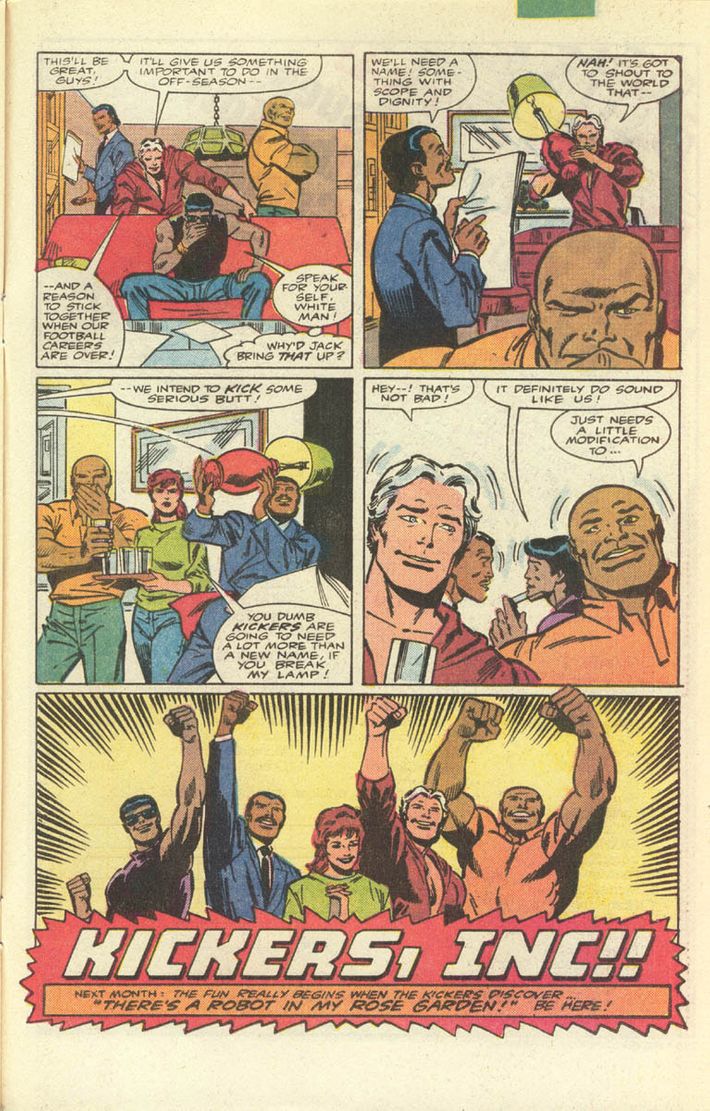
If you’re into balls-to-the-wall comic-book wackiness, you’ll love the Kickers’ first two cases. Issue two is entitled “The Robot in My Rose Garden!” and it does exactly what it says on the tin. An old lady in the Bronx sees the team appear on The Tonight Show and contacts them because she’s been terrorized by a tank-treaded robot (“One of those metal creatures — like the things in Star Wars!”) that has destroyed her beloved rose garden. The skeptical Kickers investigate and find a Middle Eastern terrorist who is, improbably, using a Bronx street gang and a giant robot to destabilize New York City as the beginning of a revolution. Our heroes destroy the machine, but opt not to tell the cops because, as Dasher puts it, “We’re talking major lawsuit if anyone finds out we were involved!” In the next issue, a mob boss hires the Kickers to investigate his son’s suicide; they find out he was driven to it by a group of Westchester-based Satanists led by a professor researching hallucinogens. They really don’t make comics like this anymore.
Behind the scenes, the conflict between Shooter and DeFalco rapidly approached its zenith. Shooter wanted more actual sports in the stories: “It’s such a great idea, and if you go through the history of football, it’s rife with heroes and villains and drama and miracles,” the erstwhile EIC says now. DeFalco was reaching his last nerve, having argued for months that the sports stuff wasn’t the point: “If you have to do something realistic, you go to other media to do that,” he says. Neither man can recall the exact moment when DeFalco and Frenz walked, which is understandable, given that Marvel had become a total nightmare.
“I was kinda up to my ears in my own problems,” Shooter recalls. He says much of his fighting was with Marvel’s new owners on his employees’ behalf, trying to save 401(k) and royalty-sharing plans. But if his people knew any of that, it didn’t outweigh their resentment of the man. At an off-site party, staffers and freelancers stuffed piles of unsold New Universe comics into a suit, affixed a photo of Shooter to its neck, and burned it in effigy. The owners saw a video of the incident and decided to handle the mutiny by throwing the captain overboard. Shooter was fired and DeFalco was promoted to EIC.
Amidst all that mishegoss, the New Universe was somehow still chugging along. Kickers needed a new writer, but if even the two guys who had come up with the concept were sick of it, one can imagine how hard it was to find someone else. Enter Terry Kavanagh, an assistant editor at Marvel with no writing experience, who was dragooned into the gig just before Shooter’s departure. “There’s a good possibility I was the absolute last choice, but I wasn’t in a position to say no,” he recalls. Yet there was an obvious problem from the beginning of his tenure, he says: “I wasn’t a sports fan.”
That was unfortunate, as his first issue had to be adapted from a DeFalco plot that was, ironically, the most sports-oriented one yet. Absolutely nothing superheroic happens: It’s a story about Jack facing a violent rival in a big game and teaching him the true meaning of sportsmanship. But Kavanagh got to stretch his wings in his next issues, which are the best of the series. There’s “Out of the Blue,” co-written by Ron Altaville, in which Jack takes a flight bound for Washington, D.C., only to find it hijacked — not by a terrorist or ransom-seeker, but rather a flight attendant fed up with the bullshit she deals with in her job: A kid won’t stop asking her about seeing the pilot, a passenger knocks over her refreshments, another won’t turn off a boom box. Finally, when a sleazebag slaps her ass, she grabs a gun (it was a different time for air travel) and takes over the plane, demanding that the pilot fly her to “Shangri-La” and threatening to shoot a child. The episode ends when she shoots at Jack, and the bullet bounces off of him and hits her in the throat, killing her. The child, curiously unfazed, shouts, “Holy mackeral [sic], Mr. Magnificent. That was really neat!”
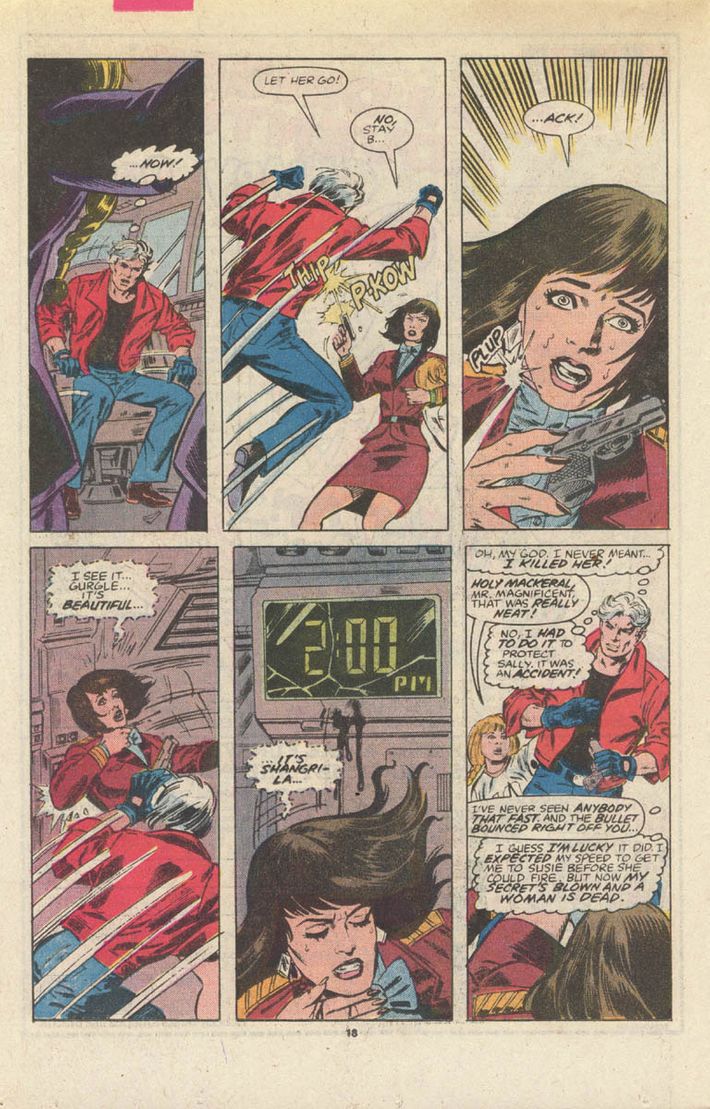
Next came “Clowntime Is Over” (what a title!), in which the Kickers take on a sinister circus run by a person whose left side is a woman in a green dress and right side is a man in a black suit. Jack accidentally kills a circus lion during the fight and spends much of the rest of the series grieving over it. “It seemed to be a title that we could have a little more fun with,” Kavanagh recalls, and with the company’s leadership structure in free fall, no one was really minding the till when he had particularly out-there ideas. In the circus issue, the lion tamer’s accent inexplicably changes from Irish to Russian to German, because Kavanagh “just thought that was fun.”
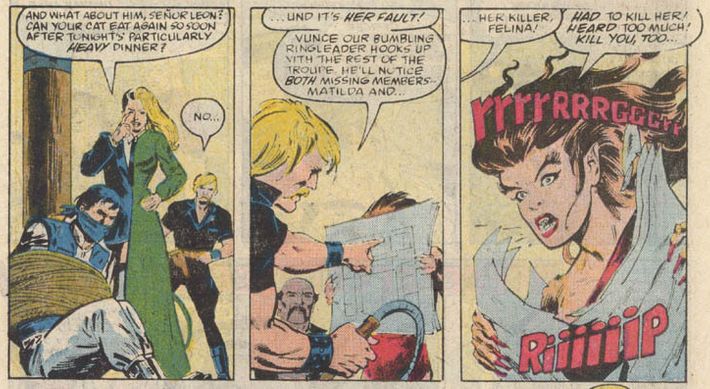
As Kavanagh tells it, financial success was secondary to him — the real joy came because it was the first time his father appreciated what he did for a living. “What was fun for me was that it gave me an excuse to sit in a bar with my dad, who was a sports fanatic, and bounce ideas off of him,” he remembers. “I don’t think he understood comic books, but he would show Kickers to all his friends. I remember being at the office and my dad calling and saying, ‘Terrence, this is your father! I’m talking to this guy who read a comic book once!’ and he put that guy on the phone with me.”
Kavanagh was removed from Kickers after issue eight because the strain of simultaneously editing and writing was putting him behind schedule, and a revolving door of writers followed. By the end, the series had become a glorious, near-incomprehensible mess. The plots skidded from stuff like the Kickers going on a covert military mission in South America to Jack playing in a charity tennis match against the Smashers’ owner’s wife. There was a subplot about the Kickers’ janitor selling cocaine. The last issue is about UFOs and Bigfoot, and resolves nothing in the end. Meanwhile, as the series progressed, Suicide’s skin color inexplicably changed from brown to white:
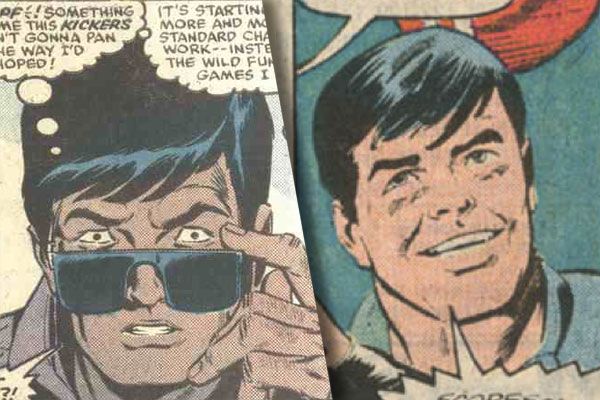
“Look, by that point, nobody who didn’t have to talk about the New Universe was talking about it,” Kavanagh says. Some of the titles continued until 1989, and Jack made cameos in a few of them, but Kickers, Inc. was gone by the end of 1987. There were tiny callbacks to it in subsequent years: Short-lived New Universe revivals came in 1994 and 2007, with versions of Jack appearing in each. Yet when the NFL and Marvel teamed up for an ill-fated cross-promotion in 1991, they chose to create a terrible new character, NFL SuperPro, instead of putting Mr. Magnificent back on the field.
Shooter still thinks Kickers “didn’t ever live up to its potential,” and DeFalco and Frenz agree, to a certain extent, with Frenz still harboring a tiny hope that the Kickers might get another chance to be what he always thought they could be. “Whether it’s by two veteran creators, or some kid who found Kickers, Inc. in a 25-cent bin and made some radical new modern-day pitch to an editor over a couple of beers, and they take it somewhere, it could happen,” he says and laughs. “Who knows, maybe someday there’ll be some fun in comics again.”

